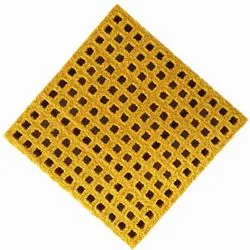loading...
- No. 9, Xingyuan South Street, Dongwaihuan Road, Zaoqiang County, Hengshui, Hebei, China
- admin@zjcomposites.com
- +86 15097380338
- Welcome to visit our website!
Current Trends in Fiberglass Rebar Pricing and Cost Analysis for Construction Projects
Understanding the Price of Fiberglass Rebar Factors and Market Trends
In the construction and civil engineering industries, the demand for innovative materials continues to grow, as professionals seek ways to improve durability, reduce maintenance costs, and enhance sustainability. One such material that has gained significant attention in recent years is fiberglass rebar, a product that offers a range of benefits over traditional steel rebar. However, like any construction material, the price of fiberglass rebar is influenced by various factors that potential buyers should understand.
What is Fiberglass Rebar?
Fiberglass rebar, also known as glass fiber reinforced polymer (GFRP) rebar, is made from a combination of glass fibers and resin. It is lightweight, non-corrosive, and resistant to chemical damage, making it an attractive alternative to conventional steel rebar, especially in environments prone to rust or corrosion, such as marine applications and chemical plants. Additionally, fiberglass rebar is non-magnetic, which is advantageous for certain applications in the aerospace and nuclear industries.
Factors Influencing the Price of Fiberglass Rebar
1. Raw Material Costs The primary components of fiberglass rebar are glass fibers and resin. Fluctuations in the price of these raw materials can significantly impact the overall cost of fiberglass rebar. Economic conditions in the countries producing these materials, along with changes in supply and demand dynamics, can lead to price fluctuations.
2. Manufacturing Processes The production of fiberglass rebar involves advanced manufacturing techniques, which can be capital intensive. Investments in technology and machinery to improve efficiency or output can affect the final price of the product. Moreover, any improvements in manufacturing efficiency may allow manufacturers to lower prices to remain competitive.
3. Market Demand As the construction industry grows, so does the demand for fiberglass rebar. This demand can vary considerably based on geographic regions, project types, and industry trends. For instance, regions experiencing substantial infrastructure development may witness a spike in demand for fiberglass rebar, which could drive prices up.
fiberglass rebar price

4. Competition The fiberglass rebar market is continuously evolving, with new players entering the arena. Increased competition among manufacturers can lead to price reductions as companies vie for market share. Conversely, if few manufacturers dominate the market, prices may remain high due to limited competition.
5. Project Specifications and Applications The required specifications for various construction projects also influence pricing. Projects with stringent quality standards may require higher-grade fiberglass rebar, which can be more expensive. Additionally, unique applications that demand custom sizes or compositions can further increase costs.
6. Transportation Costs Since fiberglass rebar is often produced in specific locales, transportation costs can impact final prices. Fluctuations in fuel prices, logistical challenges, and shipping regulations can all contribute to higher costs passed down to the consumer.
Current Market Trends
As of 2023, the market for fiberglass rebar is witnessing a steady upward trend. Many construction professionals are increasingly recognizing the long-term benefits of using fiberglass rebar, particularly in projects where corrosion is a concern. Furthermore, the push for sustainable construction practices has led to greater interest in non-corrosive materials, further elevating fiberglass rebar's profile in the market.
Despite these positive trends, price sensitivity remains a significant challenge for contractors and builders. While the initial cost of fiberglass rebar may be higher than traditional steel rebar, the overall savings on maintenance and longer lifecycle can negate the upfront expense. As education and awareness about the benefits of fiberglass rebar continue to grow, it is anticipated that adoption rates will increase, potentially stabilizing prices in the long term.
Conclusion
The price of fiberglass rebar is influenced by a complex interplay of factors, ranging from raw material costs to market competition and consumer demand. As the industry evolves, understanding these dynamics will be crucial for stakeholders in making informed purchasing decisions. For those planning construction projects, considering the long-term benefits and savings associated with fiberglass rebar can lead to better outcomes in terms of durability, maintenance, and overall project success. As awareness and acceptance of this innovative material grow, fiberglass rebar is poised to become a staple in modern construction practices.
-
The Rise of FRP Profiles: Strong, Lightweight, and Built to LastNewsJul.14,2025
-
SMC Panel Tanks: A Modern Water Storage Solution for All EnvironmentsNewsJul.14,2025
-
GRP Grating: A Modern Solution for Safe and Durable Access SystemsNewsJul.14,2025
-
Galvanized Steel Water Tanks: Durable, Reliable, and Ready for UseNewsJul.14,2025
-
FRP Mini Mesh Grating: The Safer, Smarter Flooring SolutionNewsJul.14,2025
-
Exploring FRP Vessels: Durable Solutions for Modern Fluid HandlingNewsJul.14,2025
-
GRP Structures: The Future of Lightweight, High-Performance EngineeringNewsJun.20,2025
